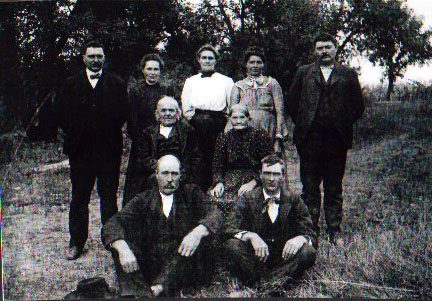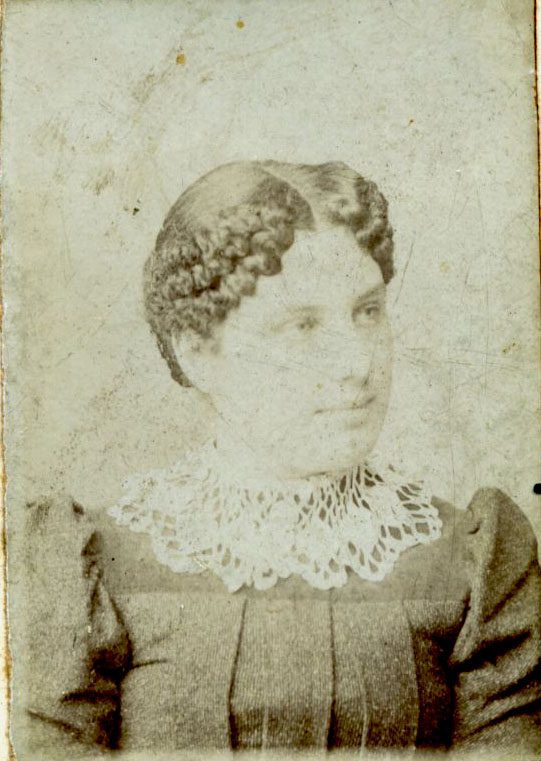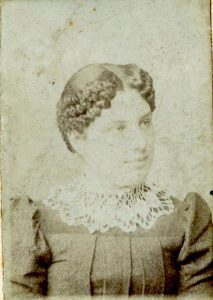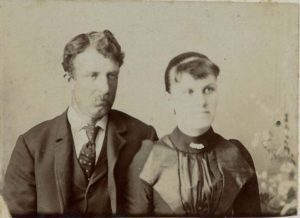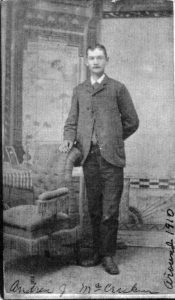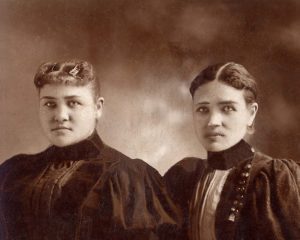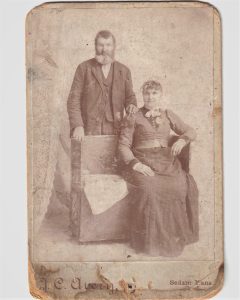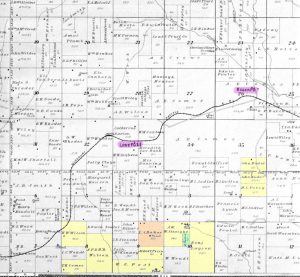
It is one thing to be related to almost everybody in the cemetery. It is another thing to be related to three of your mom’s four grandparents’ family lines through one person in that cemetery.
When you visit Lola’s grave at Clarksburg Cemetery, you are visiting with someone who ties my Carson, Pellett, and Ashby families together. And, yes, you are going to need a picture of the family tree for this one. Thus, a simplified family tree and explanation is provided at the end of the article.
Lola Mary Carson

Lola Mary Carson was the daughter of John Henry Carson. John was the son of William Henry Carson, who was the son of Henry Carson and Rebecca Fowler. Henry and Rebecca were the parents of my great-great grandmother Louisa Madeline Carson, who married George Andrew Thomas. They were ancestors in my mom’s maternal family line.
Lola grew up south/southeast of Fort Scott. In 1901, she was attending the Diamond School. At the same time, Lloyd Ashby, also attended Diamond School. Lloyd was the son of Grant and Elizabeth Ashby, who were my great-great grandparents.

Lola’s life seemed to be full of friends and good times. However, she experienced sad occasions as well. On two occasions, Lola was called upon to be a pallbearer, which I found unusual as typically men are called upon for that duty. One time was for a nine-year-old girl and another time was for one of her friends. The young girl was Martha Marsh, whose older sister Bertha later married Henry Pellett Jr., brother of my grandfather Clifford Claney Pellett.
Rufus Ezra Pellett
Fortunately, the good times outweighed the sad times. There were numerous parties in the community. Some were family celebrations and others were gatherings of young people for no reason other than to have a party.
Courtship
It is unknown when Rufus Pellett first met Lola. However, they had both grew up in Drywood Township south of Fort Scott. In September of 1916, they were both at a party hosted by Ruth Jamison. The prior month it had been reported that Rufus was working at the brick plant at Oskaloosa, Missouri, which was several miles south of Garland. He may have been making a daily journey to work. However, he may have just been home for the party.
It is not known if he continued to work at Oskaloosa; however, he was also at Ruth Jamison’s party the following March. In late May, 62 of Lola and her sisters Gladys and Pearl’s friends surprised the Carson sisters with a party. Rufus was again among the young men in attendance. In late June, their paths crossed again at a party at the Lauber home and at another in the first half of July.
The first indicator in the news that they were a couple is when they spent time with Lola’s sister Bessie and her husband Walter Hurt. Only days later in early August 1917, Lola and Rufus married, bringing together the Carson and Pellett families.
Early Married Life
Initially, they lived on Seth Pellett’s farm, which was also known as the Will Carter Farm. The following year Rufus was granted a license for explosives. Apparently, the World War had prompted the approval of more licenses. It seemed that there were many small mining operations and likely Rufus was trying to take advantage of that opportunity. Oddly, Williams Hardware Company of Hiattville was also issued a license at the same time. I really wonder why a hardware store needed an explosive license.
Not sure if the explosives business didn’t work out or not, but later Rufus was described as a farmer. The following April, Rufus rented the O.O. Barker farm west of Garland. That year Rufus had two major milestones as he got a new binder and he turned 21-years-old. The birthday was, of course, another reason for a celebration.
A Near Disaster
Later that year, disaster nearly struck when Rufus opened an umbrella while driving a buggy. The horse was spooked and took off at a full run. At the bottom of the hill, the horse fell, overturning the buggy and throwing Rufus, Lola, their baby Nola, and Clarence Johnson to the ground. Rufus had a badly bruised back, but miraculously no one else was injured.
Rufus and Lola spent the following year living near Richards, Missouri before moving back to Ezra’s farm in 1921. I can’t imagine moving around every year with little kids. Granted, families did not have as much “stuff” in their houses. However, farmers had to move all their equipment and any livestock that they owned.
In 1922, Rufus and C. A. Hahn advertised that they were quitting farming and having a sale. Eleven horses, eight cattle, corn, fodder, timothy hay, and all farm implements were included in the sale. However, three years later Rufus was farming and he appeared to continue farming for the next several years.
Moving To Town
Rufus and Lola stayed on the farm until 1931 when they moved to Fort Scott where he worked for a time for the city water department. According to the Footprints of Bourbon County, the family moved to Waterloo, Iowa in 1942, where Rufus worked at a plant that did defense work in support of World War II. After the war, they moved back to Bourbon County. This seems to contradict city records showing Rufus in Fort Scott during at least a portion of that period.
After The War
The book also stated that they purchased Lola’s grandparent’s property, which is better known as the Catt property. It contained a rock home that her Grandfather Catt had built in the 1860s. The exact date of the acquisition needs to be researched. It was sometime after March 1, 1946 as Rufus and Lola were living in Pawnee Township on that date.
In June of that year, the family had another close call with disaster. As, Lola was cooking on the kitchen stove, she saw a flash of light and was knocked to the floor. A lightning bolt had entered the home creating a four-foot-wide hole. It had also damaged the upstairs floor before continuing to the kitchen where it put a hole through the center of a chair. Lola and Rufus’ son and his wife were also in the home. Luckily, the lightning missed directly hitting any of the occupants.
Lola and Rufus’ son had been born in 1923. He was their only son and last child, following their daughters Nola Marie and Mary Lillie. Their children were doubly related to me. Their relationship to me goes as follows: Rufus was the son of Ezra Mitchell Pellett and Lillie Pearl Carver. Ezra was the son of Seth M. Pellett and Aseneth E. Crawford, who were my great-great grandparents. And, Lola was related to me through Henry Carson and Rebecca Fowler as previously described.
In late 1966, about 9 months shy of his and Lola’s 50th Anniversary, Rufus died.
William (Lloyd) Ashby
The year after Rufus died, William (Lloyd) Ashby, came to Kansas for a visit. Lloyd was a widower. He had married Emma Witt in 1915. They had both lived southeast of Fort Scott near Garland while growing up and then moved away. He had moved with his parents to an area south of Holly, Colorado, which might as well be called No Man’s Land as it is just dirt, rock, and sun. Emma, on the other hand, had moved to Hooker, Oklahoma, which was about as desolate. After they married, they had lived near Garland and he had been a clerk at the G.W. Million & Son store until they moved to California in 1919.
That visit resulted in a marriage between Lloyd and Lola. Grandma Pellett told the story of how they came to marry. During Lloyd’s visit, someone (maybe her, we are not sure on that detail) took Lloyd around to all the widow’s homes to visit. As the story goes, he stayed the longest at his old schoolmate Lola’s home. They married in Atascadero, CA just over a year after Rufus died. Lloyd was 75 and Lola was almost 71 at the time of their marriage.
Lola outlived Lloyd. He is buried at Atascadero, California. Lola returned to Kansas and is buried at Clarksburg Cemetery.
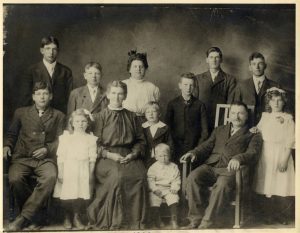
Lloyd was the son of Grant and Elizabeth Ashby. Their daughter Sarah Ellen “Sadie Ella” or simply “Ella” was my great-grandmother.
Coming Full Circle
To complete the connection, Grant and Elizabeth Ashby’s granddaughter, my grandmother Dessie May (Thomas) Pellett, was also the granddaughter of Louisa Madeline Carson and George Andrew Thomas (g-grand of Henry Carson and Martha Fowler) married Clifford Claney Pellett grandson of Seth and Asenith Pellett. My mom’s Conner family is the only one without a connection to that one gravestone!
The Connections Explained
The following chart shows the connections of these three people to me. Each family line is represented by a color group. The shades of each color are to help visualize the family line of key people in the article vs. my ancestors in those families. The male of the family is shown without the spouse due to space limitations except where critical to show the connection between families.
To read the chart:
- The center line shows common ancestors between myself and the key people in the article.
- The key people in the article are the top person in each column above the center line.
- Ancestors of the people in the article are read from top to bottom.
- My ancestors connecting to these families are shown underneath the center line.
- Ancestors are read from bottom to top.
- Key marriages are shown with a light yellow background.



